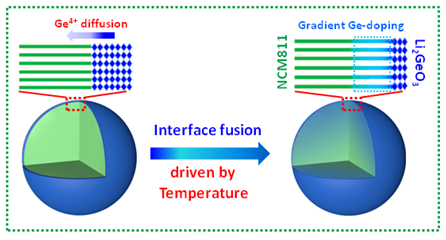Coating and doping make improved cathode - Dr. Shengcai Zhu
MARCH 4, 2019
New work from Dr. Shegncai Zhu of HPSATR, collabrated with Dr. Jun Yang from Shaanxi University of Science and Technology and Prof. Yongyao Xia from Fudan University, found that overall structural modification integrating coating and gradient doping could enhance the structural stability and simultaneouly facilitate Li+ diffusion of layered Ni-rich cathode at high voltage. The work is published in recent Journal of Materials Chemistry A.
Lithium-ion batteries (LIBs) are renewable and high-efficiency energy storage systems with wide application, such as portable electronics, smart power stations and electric vehicles. In particular, the practical LIBs in powering electric vehicles should contain high energy and power density. In this regard, layered Ni-rich oxide LiNi0.8Co0.1Mn0.1O2 is a promising cathode material due to its high reversible capacity (200 mAh g-1) and low cost.
“The vital challenge for LiNi0.8Co0.1Mn0.1O2 material is the severe structural degradation at high voltage, which causes the serious electrode polarization and electrochemical performance deterioration,” said Prof. Xia. “To date, the most general approach for the surface modification could just partially alleviate the degradation associated with surface structure, but fails to resolve the inevitable cation mixing within the cathode structure. While lattice doping is considered as an effective strategy to tune the crystal structure and improve the structural stability, while the surface structural degradation is still a serious problem for the doped cathode.” Dr. Yang added. “We need to find a strategy that one stone hit two birds —inhibiting the interfacial reaction while supressing the inner cation mixing?
The team applied an integrated structural modification method by combining Li2GeO3 coating with gradient Ge-doping to improve the structural stability and diffusion kinetic of Li ion of the layered Ni-rich cathode.
They found that the Li2GeO3 coating inhibited the interfacial side reaction and thus enhanced surface structural stability of cathode materials. At the meantime, the gradient Ge-doping effecively suppressed cation mixing and improved the ordered channels for Li+ ions transportation.
Their further first principle calculations also reveals that Ge-doping not only alleviates the structural degradation by increasing the phase transition energy barrier but also facilitate the fast Li+ diffusion/transportation by reducing the diffusion barrier. “We are surprised that very low Ge doping(~0.2%)can make such a big difference”. said Dr. Zhu. This work provides a design idea for stabilizing surface/bulk structure of advanced cathode for high-performance Li-ion batteries.

Caption: The schematic illustration for the formation of Li2GeO3 coating layer and gradient doping structure on Ni-rich cathode particle.
LiNi0.8Co0.1Mn0.1O2是一种新型锂离子电池正极材料,以高的高能量密度,生产成本低而成为潜在的锂离子正极材料。然而由于Ni很容易与电解液发生负反应,产生气体,引发安全隐患。另外层状结构中的过度层会与Li原子层发生混排,致使材料失活,导致电池材料寿命短缩短。该研究结合实验及理论计算提出了一种在表面包覆的同时对材料进行体相掺杂来一步完成抑制表面化学反应及结构的转变的新思路。他们的方法在效抑制了LiNi0.8Co0.1Mn0.1O2的表面活性的同时提高了锂离子的传输效率从而改善了该正极材料的循环性能。
